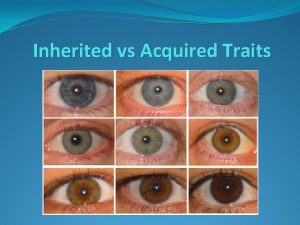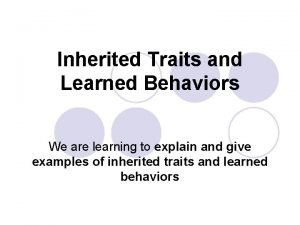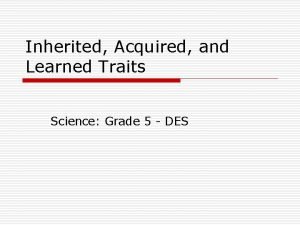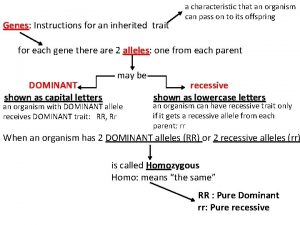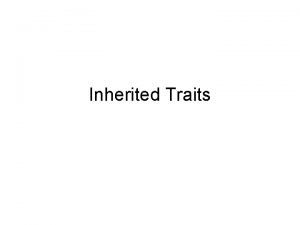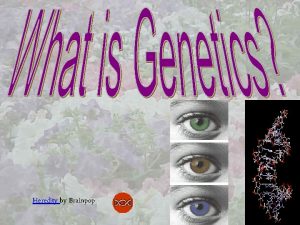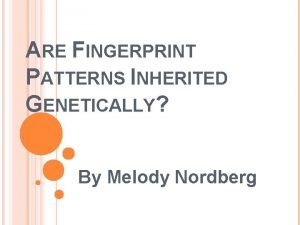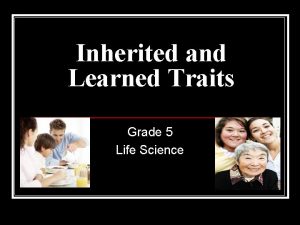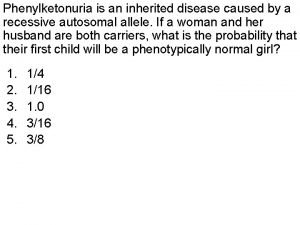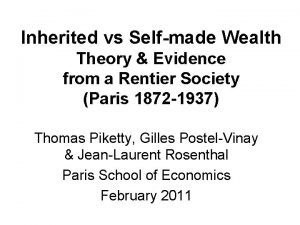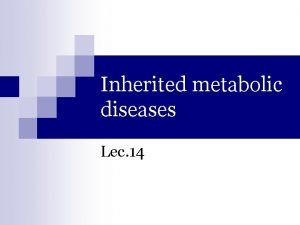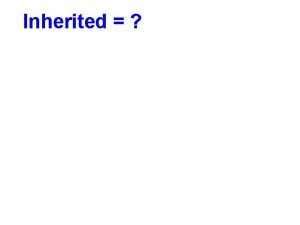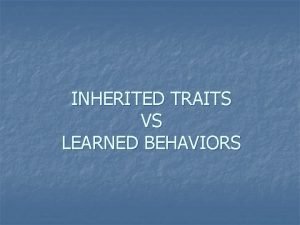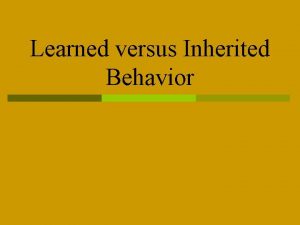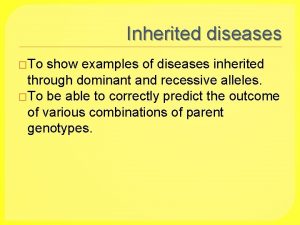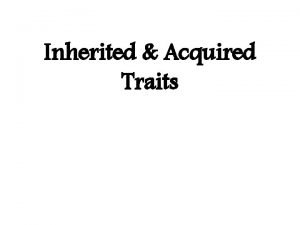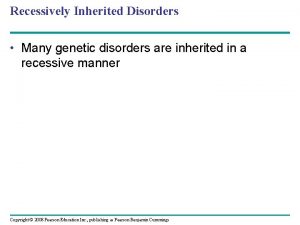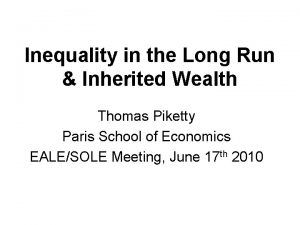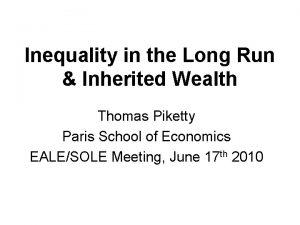Inherited vs Selfmade Wealth Theory Evidence from a



























- Slides: 27

Inherited vs Self-made Wealth Theory & Evidence from a Rentier Society (Paris 1872 -1937) Thomas Piketty, Gilles Postel-Vinay & Jean-Laurent Rosenthal Paris School of Economics February 2011

• Q. : What do we know about the relative importance of inherited wealth vs self-made wealth? • A. : Very little… • & very controversial: Kotlikoff-Summers JPE 1981: inherited wealth = 80% of total US wealth accumulation Modigliani AER 1986: inherited wealth = 20% of total US wealth accumulation… → This extreme confusion is due both to illdefined concepts (inadequate representative agent framework) and to bad data

What this paper does (1) We propose a new theoretical definition of the share of inherited wealth in aggregate wealth, based upon the division of population into two groups : « inheritors » (or « rentiers » ) vs « savers » (or « self-made men » ). Straightforward, but completely different from standard, representative-agent definitions (2) We apply this definition to new data base on inheritance and matrimonial property regimes which we collected using individual estate tax records in Paris 1872 -1937

What we find • Paris 1872 -1937 = quintessence of a « rentier society » : top successors, by consuming the return to their inherited wealth, can sustain living standards which are very hard to attain via labor income • Rentiers: 10% of population, but 60%-70% of wealth • Total share of inherited wealth = 70%-80% • Rentiers = only 25% of « middle class » (wealth fractile P 50 -90), but 50% of « middle rich » (P 9099), & 70% of « very rich » (P 99 -100) • Even at the very top, we always find 25%-30% of self-made men. But they are a minority. Two very different groups. Representative agent models are inappropriate to study wealth accumulation.

Do rentiers belong to the past? ● • - • No modern data source is as rich as our 1872 -1937 Paris data base; with modern data, we would probably find lower rentiers shares; but it is impossible to say at this stage One should not over-estimate how much the world has changed since 1900: Aggregate inheritance flows – as compared to aggregate income & wealth – will probably be as large in 21 C as in 19 C (r>g logic): see Piketty, « On the Long-Run Evolution of Inheritance – France 1820 -2050 » Wealth concentration did not decline all that much: top 10% share = 87% France 1912, 72% US 2007 (lower bound) In any case, critical point: these important issues need to be studied with proper concepts & data; wealth accumulation always involves 2 very different kinds of people (inheritors vs savers); representative-agent models are inappropriate



Theory 1: basic notations • Population = Nt , Aggregate private wealth = Wt • National income Yt=YLt+rt. Wt, where YLt = labor income, and rt = average rate of return on private wealth • wt=Wt/Nt = per capita wealth, y. Lt=YLt/Nt = per capita labor income, yt=y. Lt+rtwt = per capita national income • Consider a given individual i with wealth wti at time t. Assume he or she received bequest bti 0 at time ti<t. • Note bti* = bti 0 er(ti, t) the capitalized value of bti 0 at time t (where r(ti, t) is the cumulated rate of return between time ti and time t).

Theory 2: definitions • • Nt = Nt r + Nt s Ntr = “inheritors” (or “rentiers”) = {i s. t. wti<bti*} Nts = “savers” (or “self-made men”) = {i s. t. wti>bti*} By construction: during their lifetime, inheritors have consumed more than their labor income, while savers have consumed less than their labor income • Rentier share in population ρt =Ntr/Nt • Average rentiers wealth: wtr=E(wti | wti<bti*) • Average savers wealth: wts=E(wti | wti≥bti*) • Average capitalized bequests: btr*=E(bti* | wti<bti*) (rentiers) bts*=E(bti* | wti≥bti*) (savers) • Rentier share in wealth πt=ρtwtr/wt • Share of inherited wealth in aggregate wealth: φt = [ρtwtr + (1 -ρt)bts*]/wt = πt + (1 -ρt)bts*/wt

Exemple 1 • At age a=60, Mr Martin owns a Paris apartment worth 500, 000€ (net of outstanding mortgage liabilities), 100, 000€ in equities, another 300, 000€ in mutual funds. • At age I=30, he inherited 400, 000€ in life insurance assets from his parents, which he does not own any more. • So wti=900, 000€ and bti 0=400, 000€. With I=30, a=60 and r=4%, then er(a-I)=332% and bti*=1, 328, 000€ = 400, 000€ (capital value) + 928, 000€ (cumulated return). • That is, bti*>wti, i. e. according to our definitions Mr Martin is an “inheritor” (or a “rentier”): during his lifetime he consumed more than his labor income (what his labor income flows and portfolios choices might have been)

Exemple 2 • At age a=60, Mr Smith owns a small house worth 60, 000€ (net of outstanding mortgage liabilities), and 20, 000€ in various savings accounts. He inherited 10, 000€ from his parents at age I=30, which he spent when he contracted a loan to purchase his house. So wti=80, 000€, bi=10, 000€, and bti*=33, 000€. So we have bti*<wti. Mr Smith is a “saver”: over his lifetime he consumed less than his labor income • Now consider a hypothetical economy where 20% (ρt) of the population are inheritors like Mr Martin and 80% are savers like Mr Smith. Then inheritors’ share of aggregate wealth πt is ρtwtr/wt =74%, and the total share of inherited wealth in aggregate wealth is φt=πt+(1 -ρt)bts*/wt =85%.

Difference with standard definitions • Both Kotlikoff-Summers adopt a representative-agent framework: • Kotlikoff-Summers: φt. KS = bt*/wt • Modigliani: φt. M = bt/wt → Modigliani definition is artificially low (returns to wealth are basically ignored…), while Kotlikoff-Summers definition is artificially high (it can easily be larger than 100%, even in an economy with a significant fraction of savers and self-made wealth) → One needs to distinguish between two groups

Applying the definitions to a new data base on inheritance & wealth • Continuation of Piketty-Postel-Vinay. Rosenthal AER 2006, « Wealth Concentration in a Developping Economy: Paris & France 1807 -1994 » • Novelty: for 1872 -1937 we collected extra data on matrimonial regimes (community vs separate assets) → this allows to measure directly the share of inherited wealth (without matching two generations!)




Table 4: Asset composition in Paris 1872 -1937 (% gross assets) Real estate assets Financial assets inc. Equity inc. Private bonds inc. Govt bonds inc. Total Other, foreign Furnitures cash, . . assets 1872 34% 64% 17% 21% 15% 10% 7% 3% 1882 35% 63% 18% 21% 16% 9% 8% 2% 1912 36% 62% 20% 18% 14% 9% 20% 3% 1922 27% 69% 25% 13% 19% 11% 15% 4% 1927 23% 71% 37% 10% 13% 11% 20% 6% 1932 27% 66% 30% 11% 14% 11% 7% 1937 25% 69% 35% 10% 11% 12% 22% 7% Note: Out-of-Paris real estate assets are missing in 1872 -1882; in 1912 -1937, they make about 1/3 of real estate assets

Table 5: Community asset composition in Paris 1872 -1937 (% gross assets) Real estate assets inc. Financial inc. Private assets Equity bonds inc. Govt bonds inc. Total Other, foreign Furnitures cash, . . assets 1872 34% 63% 20% 11% 12% 5% 3% 1882 31% 66% 24% 19% 12% 11% 6% 3% 1912 29% 68% 27% 14% 11% 21% 3% 1922 17% 78% 30% 14% 22% 13% 5% 1927 12% 81% 46% 10% 13% 12% 24% 7% 1932 16% 77% 35% 12% 15% 11% 8% 1937 15% 76% 42% 11% 12% 20% 9% Note: Out-of-Paris real estate assets are missing in 1872 -1882; in 1912 -1937, they make about 1/3 of real estate assets

Table 6: Inherited asset composition in Paris 1872 -1937 (% gross assets) Real estate assets Financial assets inc. Equity inc. Private bonds inc. Govt bonds inc. Total Other, foreign Furnitures cash, . . assets 1872 43% 56% 14% 18% 16% 8% 8% 1% 1882 43% 55% 18% 15% 8% 6% 2% 1912 45% 54% 17% 16% 10% 9% 11% 1% 1922 33% 63% 24% 11% 17% 11% 4% 1927 32% 63% 34% 8% 9% 13% 15% 4% 1932 39% 57% 29% 8% 11% 8% 12% 3% 1937 43% 53% 28% 9% 8% 8% 14% 4% Note: Out-of-Paris real estate assets are missing in 1872 -1882; in 1912 -1937, they make about 1/3 of real estate assets






What have we learned? • The wealth accumulation process always involves 2 very different kinds of people: inheritors vs savers • Our new definition of the share of inherited wealth in aggregate wealth is more appropriate than the standard representative-agent definition • In order to properly analyze capital accumulation, macroeconomics needs to go beyond representative agent models… • …& beyond infinite horizon models with idyosincratic shocks, which are inappropriate to study inherited vs self-made wealth → one needs to model explicitly the existence of different, unequal social groups with finite horizon


 Secondary sources
Secondary sources Primary evidence vs secondary evidence
Primary evidence vs secondary evidence Primary evidence vs secondary evidence
Primary evidence vs secondary evidence Primary evidence vs secondary evidence
Primary evidence vs secondary evidence Jobs vancouver
Jobs vancouver Are fibers class evidence ?
Are fibers class evidence ? Class vs individual evidence
Class vs individual evidence Difference between class and individual evidence
Difference between class and individual evidence Class vs individual evidence
Class vs individual evidence Ecologic fallacy
Ecologic fallacy How is thalassemia inherited
How is thalassemia inherited If katie has brown eyes a dominant trait we know
If katie has brown eyes a dominant trait we know Inherited vs acquired traits
Inherited vs acquired traits Elephant inherited traits
Elephant inherited traits Inherited behaviors examples
Inherited behaviors examples Behavioral trait
Behavioral trait Inherited and acquired traits
Inherited and acquired traits Homocigoto dominante
Homocigoto dominante Blood type inheritence
Blood type inheritence An unchanging, biologically inherited behavior pattern.
An unchanging, biologically inherited behavior pattern. What inherited traits do elephants have
What inherited traits do elephants have A gene carries the ________ for a trait. brainpop
A gene carries the ________ for a trait. brainpop Are fingerprints genetically inherited
Are fingerprints genetically inherited Millionaire game rules
Millionaire game rules Inherited behavior examples
Inherited behavior examples Learned traits examples
Learned traits examples Acquired trait
Acquired trait Pku hereditary
Pku hereditary












